Romanian Air Force
| Romanian Air Force Forțele Aeriene Române | |
|---|---|
|
Romanian Air Force Coat of Arms | |
| Founded | 1 April 1913 |
| Country | Romania |
| Size | 9,700 personnel[1] |
| Part of | Romanian Armed Forces |
| Command HQ | Statul Major al Forțelor Aeriene - Bucharest |
| Anniversaries | 20 July[2] |
| Commanders | |
| Chief of the Air Force Staff | Major General Laurian Anastasof |
| Insignia | |
| Roundel |
 |
| Aircraft flown | |
| Attack | MiG-21 LanceR 'A', IAR-330 SOCAT |
| Fighter | MiG-21 LanceR 'C', Lockheed Martin F-16 |
| Interceptor | Lockheed Martin F-16 |
| Reconnaissance | Antonov An-30, RQ-7 Shadow |
| Trainer | MiG-21 LanceR 'B', IAR-99, IAR 316, Yak-52 |
| Transport | C-130 Hercules, C-27J Spartan, Antonov An-26, IAR-330L/M Puma |
The Romanian Air Force (Romanian: Forţele Aeriene Române) is the air force branch of the Romanian Armed Forces. It has an air force headquarters, an operational command, four air bases and an air defense brigade. Reserve forces include two air bases and three airfields.
In 2010, the Romanian Air Force employed 9,700 personnel.
Current state
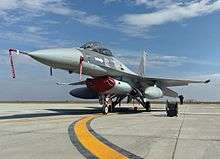
The Romanian Air Force modernized 110 MiG 21 LanceRs, in cooperation with Israel between 1993 and 2002. Today, 48 of these MiG 21 LanceRs are operational.[3] The Romanian Air Force also operates C-130 Hercules, C-27J Spartan, An-26s transport planes and IAR-330 Puma helicopters. IAR-330 PUMA SOCAT helicopters have been modernized by the Romanian Aviation Industry in cooperation with Elbit Systems (Israel) for attack missions. The Romanian Air Force also includes locally built IAR-99 Şoim jet planes, in general only used for training of the young pilots. The remaining MiG-29s have been removed from service in 2003.
Due to the old age of the MiGs, the Romanian Air Force is in the procees of procurement of new fighters or possibly used fighters from partner states. Romania has signed a contract in 2013 with Portugal for 12 F-16 A/B Block 15 MLU fighters.[4] The first six fighters have entered service with the Romanian Airforce in october 2016, with three more to come by the end of the year. The last three will enter service during 2017.[5]
Beside the 12 F-16s bought from Portugal, Romanian authorities intend to buy at least another 24 F-16s, possibly newer Block 50 ones, in at least two batches of 12.[6]
In the spring of 2009, the Romanian government decided to purchase VSHORAD/SHORAD systems from France.[7] The deal included Mistral MANPADS and MICA VL surface-to-air missiles.[8] However, after preliminary talks with MBDA in August, the deal was put on hold and canceled afterwards because of the defense cuts.[9]
In February 2010, the Supreme Council of National Defense signed an agreement with the United States for missile defense under whose terms land-based SM-3 systems would be installed in Romania. On 3 May 2011, the president of Romania Traian Băsescu announced the location for the SM-3 systems: former Air Force base Deveselu in Olt County.[10] The system includes 3 batteries with 24 SM-3 Block I rockets, manned by approximately 200 US soldiers (with a maximum of 500) under Romanian Air Force overall command. The Deveselu Aegis Ashore site has been declared operational on the 13th of May 2016.[11]
The current chief of the Romanian Air Force Staff, succeeding Major General Fănică Cârnu on 19 December 2013, is Major General Laurian Anastasof.[12]
History
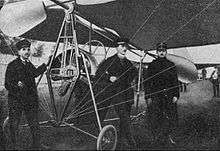

Beginnings
In 1818, during the reign of John Caradja, the prince of Wallachia, an unmanned hot air balloon was flown off Dealul Spirii in Bucharest.[13] On July 7, 1874, Colonel Nicolae Haralambie with Ion Ghica and a third person flew over Bucharest in a hydrogen balloon named "Mihai Bravul", which had made its first flight on June 9 of the same year.
On November 20, 1909 the Chitila Piloting School was formed as a joint venture by Mihail Cerchez. The school, conducted by French flight instructors, had five hangars, bleachers for spectators and shops where the Farman planes imported from France were assembled. The school opened on July 9, 1910, when the chief flight instructor and director of the school René Guillemin crashed a Farman III biplane from a height of 40 metres (130 ft) during a demonstration flight and broke his leg.
Guillemin was succeeded by Michel Molla who made the first flight across Bucharest on September 7, 1910. Molla was succeeded by two others before the school closed in late 1912 due to financial difficulties, having trained six officers, but only licensed two.[14]
In November 1909, the Romanian Minister of War commissioned Aurel Vlaicu to build the A. Vlaicu I airplane at the Bucharest Army Arsenal which first flew on June 17, 1910. On September 28, during the Fall military exercise, Vlaicu flew his airplane from Slatina to Piatra Olt carrying a message, Romania thus becoming the second country after France to use airplanes for military purposes. Along with other Romanian pilots, Vlaicu flew reconnaissance missions during the Second Balkan War. [15] [16] [17] Vlaicu III, the first metal aircraft in the world, was completed after his death, in May 1914.[18]
World War I
During World War I, Romania acquired 322 aircraft from France and ex-RNAS aircraft from Great Britain including Nieuport 11 and 17 single seat fighters and Morane-Saulnier LA and Nieuport 12 two seat fighters. Caudron G.3, Henry Farman HF.20, Farman MF.11, and Farman F.40 & 46 artillery observation and reconnaissance aircraft, Caudron G.4, Breguet-Michelin BLM and Voisin LA bombers.[19] On September 16, 1916, a Romanian Farman F.40 downed an Imperial German Air Force aircraft near Slobozia; this was the first Romanian Air Force victory. By the end of World War I, Romanian pilots had flown about 11,000 hours and 750 missions; however, it was unable to prevent the December 1916 Romanian offensive at the Battle of the Arges from being defeated, which resulted in the occupation of Romania, and an armistice on 6 December 1917.[20]
Interwar Period
During the interwar period, the RoAF, second only to Poland among the future Warsaw Pact countries, had a powerful national aircraft industry which designed and produced all types of military and most civil aircraft. In particular, the IAR 80 series were stressed-skin fighters, worthy to rank with the other single-seat fighters of WWII, and used in significant numbers on the Eastern Front.
The RoAF was reorganized during an 18-year period. Over 2,000 military and civil aircraft were built in Romania, based on local and licensed foreign designs. The military aviation used IAR 80 fighters, which became famous on the Eastern Front, and bombers manufactured by IAR Braşov. Messerschmitt Bf 109 and Heinkel He 112 fighters, Heinkel He 111 and Junkers Ju 88 bombers, Junkers Ju 87 dive bomber, Junkers Ju 52 transport and Heinkel He 114 seaplanes were purchased from Germany in the interwar period.
World War II
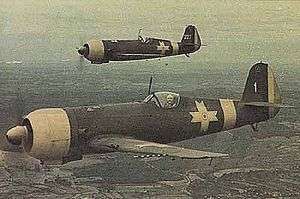
When Romania, allied with Nazi Germany, went to war against the USSR on June 22, 1941, the Romanian Air Force had 621 airplanes, including its locally made fighter IAR 80/81. The air force accomplished hundreds of missions, contributing to Romania's recapture of Northern Bucovina and Basarabia, which had been occupied by the Soviet Union a year earlier. Until the Odessa episode, the Romanian military fighters gained 661 air victories. Romanian Military Aviation fought on the Eastern front until August 22, 1944, bringing an important contribution to the great battles in Stalingrad, Crimea, and the Ukrainian fronts. Between 1941-1944, Romanian aircraft won 2,000 air victories. The most famous flying aces were Captain Prince Constantin Cantacuzino, who gained 68 certified victories, Captain Horia Agarici and Captain Alexandru Şerbănescu, who shot down 60 enemy airplanes.
Following King Michael's Coup in August 1944, Romania turned against Germany and joined the allies.
Cold War
.jpg)
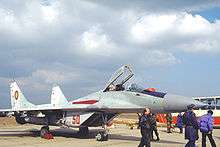
Starting with 1948, Romania tailored its military to Soviet concepts and doctrine. On February 15, 1949, the Aviation Command was established based on the Soviet model (regiments instead of flotillas). New Soviet aircraft, such as Yakovlev Yak-18, Polikarpov Po-2, Lavochkin La-9, Tupolev Tu-2, and Ilyushin Il-10 entered service. A year later, 77 Yakovlev Yak-17s and Yak-23s entered the air force, and in 1952, other 88 aircraft: MiG-15 and MiG-17. In 1958, the first supersonic fighter MiG-19 entered the inventory. Three years later, in February 1962, a new fighter was added to the inventory, MiG-21, which represented one of the most effective fighters of that time.
Starting with 1974, Romanian-made aircraft supplemented the already existing jets. The Romanian IAR-93 attack aircraft flew its first flight on 31 October 1974. It represented a great step forward taking into account that it was the only jet fighter not made by the Soviets, the only one ever manufactured and operated by a Warsaw Pact country.
In 1962, the first helicopter subunits were established and followed later on, in 1965, by the first Soviet Mi-2 and Mi-4 helicopters. Renewing the aircraft fleet process went on, the first 12 MiG-23s entering the service between July–September 1979.
On 14 May 1981, at 20:16, Soviet spaceship Soyuz-40 was launched from Baikonur to perform a common Romanian-Soviet flight, with Lieutenant Dumitru Prunariu and Colonel Leonid Popov as commander on board. During the early 1980s, 67th Fighter-Bomber Regiment and 49th Fighter-Bomber Regiment from Craiova and Ianca were equipped with new IAR-93s, which replaced old MiG-15s and MiG-17s. In December 1989, just a few days before the Romanian revolution against communism began, MiG-29 aircraft entered the Air Force inventory.
Since 1990

2007 Baltic Air Policing
Four MiG-21 LanceR Cs were deployed from August–November 2007 at Šiauliai, in Lithuania for Baltic Air Policing. The Romanian detachment succeeded the French Air Force Mirage 2000Cs of Escadron de Chasse 01.012 from Cambrai, which fulfilled the Baltic Air Policing since May 2007. Once the RoAF finished its three-month stint, a Portuguese Air Force detachment took over the mission.[21]
The four aircraft and most of the staff came from the 71st Air Base. A total of 67 personnel, among them nine pilots, were part of the detachment: 63 served at Šiauliai, while other four served at the air traffic control centre in Kaunas, to ensure smooth cooperation with local authorities. The Romanian detachment attracted attention from the local media, not least from the fact that it was only the second time a fighter from the Soviet era deployed to Šiauliai - Polish Air Force MiG-29s had also been deployed there in 2006.[22]
Structure
Air Force Staff
The Romanian Air Force Staff represents the military concept-developing, command and executive structure providing Air Forces peacetime, crisis and wartime leadership in order to reach, maintain and increase, as required, the operational level of the military subordinated structures so that to be able to operate under authorized commands responsible for military operations planning and conduct.
Generate, mobilize, structure, equip, operationalize and regenerate the required forces, provide the logistic support necessary to conduct military operations and based on higher orders, take over both the Joint Operation Air Component and independent air operations command and control, through the Main Air Operational Center. Starting with July 1, 2010, the Romanian Air Force bases were renamed to Air Flotillas.[23]
Air bases
The Romanian Air Force has 5 active air bases:[24]

![]() 71st Air Flotilla - Câmpia Turzii
71st Air Flotilla - Câmpia Turzii
- 711th Fighter Squadron - operating MiG-21 LanceR A, B;
- 712th Fighter Squadron - operating MiG-21 LanceR B, C;
- 713th Helicopter Squadron - operating IAR-330L/M;
- 714th Helicopter Squadron - operating IAR-330L/M (located at Giarmata Airport - former 93rd Air base);
- 861st Fighter Squadron - operating MiG-21 LanceR B, C;
- 862nd Fighter Squadron - operating MiG-21 LanceR A, B;
- 863rd Helicopter Squadron - operating IAR-330L/M (located at Mihail Kogălniceanu Airport - former 57th Air Base);
- 53rd Fighter Squadron - operating Lockheed Martin F-16's upgraded to the MLU standard.
- 951st Fighter Squadron - operating MiG-21 LanceR A, B;
- 205th School Fighter Squadron - operating MiG-21 LanceR B;
- 952nd Helicopter Squadron - operating IAR-330L/M;
![]() 90th Airlift Flotilla - Bucureşti - Otopeni
90th Airlift Flotilla - Bucureşti - Otopeni
- 901st Strategic Transport Squadron - operating C-130H Hercules;
- 902nd Transport and Reconnaissance Squadron - operating An-26, An-30 and C-27J Spartan;
- 903rd Transport Helicopter Squadron - operating IAR-330L/M;
- 904th Attack Helicopter Squadron - operating IAR-330 SOCAT;
- 905th Attack Helicopter Squadron - operating IAR-330 SOCAT;
142nd Reconnaissance Squadron - Timișoara - Giarmata - operating Shadow 600 UAVs
![]() Aurel Vlaicu Flight School - Boboc
Aurel Vlaicu Flight School - Boboc
- 201st School Squadron - operating Yakovlev Yak-52;
- 202nd School Squadron - operated Antonov An-2 until July 2010;
- 203rd School Squadron - operating IAR-99 Standard;
- 204th School Squadron - operating IAR-99 Şoim;
- 206th School Squadron - operating IAR-316B Alouette III;
Reserve air bases
- Constanţa - Mihail Kogălniceanu Airport - 57th Air Base
- Timişoara - Giarmata Airport - 93rd Air Base
There are also 3 airfields included in the reserve forces.
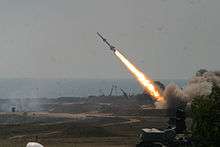
Units
76th Brigade reconnaissance and surveillance * NEW
 1st SAM Brigade "General Nicolae Dăscălescu"
1st SAM Brigade "General Nicolae Dăscălescu"  11th SAM Regiment "Horea" - located near Braşov
11th SAM Regiment "Horea" - located near Braşov- 91st Logistics Base - Bucharest
- 70th Aviation Engineer Regiment - Bucharest
- 85th Signal Battalion - Curtea de Argeş
Capu Midia range
The Capu Midia training camp and surface to air firing range provides firing training, execution and evaluation facilities. It is located in Constanţa County, 20 kilometres (12 mi) north of the city of, Constanţa.
Aircraft
Current inventory
| Aircraft | Origin | Type | No. used | Notes |
|---|---|---|---|---|
| AAI RQ-7 Shadow 600 | United States | Surveillance UAV | 6[25] | |
| Alenia C-27J Spartan | Italy | Transport aircraft | 7[26] | |
| Antonov An-26 | Soviet Union | Transport aircraft | 2[27] | |
| Antonov An-30 | Soviet Union | Surveillance aircraft | 2[27] | |
| Boeing C-17 Globemaster III | United States | Transport aircraft | 3 | Shared within NATO Heavy Airlift Wing.[28][note 1] |
| General Dynamics F-16 Fighting Falcon | United States | Multirole fighter aircraft | 6 | 12 ex-Portuguese F-16MLU's ordered. 6 have been delivered as of September 2016.[27] |
| Lockheed C-130H Hercules | United States | Transport aircraft | 4[27] | |
| Mikoyan-Gurevich MiG-21 LanceR | Soviet Union | Fighter aircraft | 36[29] | Modernized version with Elbit Systems[30] |
| IAR 316 | Romania | Trainer / light attack helicopter | 6[1] | License-built SA 316B Alouette III |
| IAR 330 Puma | Romania | Transport / utility helicopter | 35[27] | License-built SA 330 Puma |
| IAR 330L SOCAT | Romania | Attack helicopter | 22[27] | Modernized version with Elbit Systems |
| IAR 99 Șoim | Romania | Trainer / light attack aircraft | 19[27] | |
| Yak-52 | Romania | Trainer aircraft | 12[1] | License-built by Aerostar.[30] |
Air Defense
| Name | Origin | Type | In service | Notes | ||
|---|---|---|---|---|---|---|
| Surface-to-air missiles | ||||||
| S-75 Dvina | USSR | SAM system | 18 batteries[31] | |||
| 2K12 Kub | USSR | mobile SAM system | 10 units[31] | tracked Self-propelled anti-aircraft | ||
| Gepard[32] | Germany | Self-propelled anti-aircraft weapon | 36[33] | Plus 7 vehicles for spare parts. | ||
| ZSU-57-2 | USSR | Self-propelled anti-aircraft gun | 60 units[31] | tracked Self-propelled anti-aircraft gun | ||
| MIM-23 | US | surface-to-air missile | Hawk PIP-III R Variant; To be modernized to the HAWK XXI or an equivalent standard by 2018.[32][34] | |||
| Air Defence Artillery | ||||||
| KS-19 100mm | USSR | Mobile anti-aircraft | 30 units[31] | towed gun | ||
Aircraft markings
The Romanian roundel uses the colours of the Romanian flag. It is used on Romanian Armed Forces vehicles and Romanian Air Force aircraft.
 Roundel used for aircraft and vehicles from 1915 to 1941, 1944 to 1950 and since 1984.
Roundel used for aircraft and vehicles from 1915 to 1941, 1944 to 1950 and since 1984. Marking used by Romanian Royal Air Force, and Romanian Royal Army from 1 May 1941 to 3 September 1944.
Marking used by Romanian Royal Air Force, and Romanian Royal Army from 1 May 1941 to 3 September 1944..svg.png) Romanian Roundel used from 1950 to 1984 while under Communist rule.
Romanian Roundel used from 1950 to 1984 while under Communist rule.
Ranks and insignia
See also
References
Notes
- ↑ Heavy Airlift Wing (HAW) is within SAC group which includes Bulgaria, Estonia, Hungary, Lithuania, the Netherlands, Norway, Poland, Romania, Slovenia, United States, Sweden and Finland with shared costs for three C-17s.
Footnotes
- 1 2 3 International Institute for Strategic Studies, The Military Balance 2010, page. 158
- ↑ "Ziua Aviaţiei Române şi a Forţelor Aeriene. 100 de ani de aviaţie militară". Stiriletvr.ro. 24 December 2014. Retrieved 24 December 2014.
- ↑ 9am.ro, Bătălia giganţilor pentru aviaţia militară românească ("Battle of giants for the Romanian Air Force"), from Ziua, November 7, 2005
- ↑ "Events Calendar: Dec 2014". Aviation International News. Retrieved 24 December 2014.
- ↑ "VIDEO Avioanele F-16 au intrat oficial in serviciul Fortelor Aeriene Romane. Prima reprezentatie pe cerul Romaniei". HotNewsRo. Retrieved 2016-10-26.
- ↑ "Primele 6 avioane F-16 au intrat in dotarea armatei romane. Dacian Ciolos: Este o zi istorica pentru Romania si pentru Fortele Aeriene Romane". HotNewsRo. Retrieved 2016-10-26.
- ↑ "Defense & Security Intelligence & Analysis: IHS Jane's - IHS". Retrieved 24 December 2014.
- ↑ Cer Senin Magazine, nr. 3/2009, page 10
- ↑ "Defense under external pressure". Retrieved 24 December 2014.
- ↑ "Băsescu anunţă locul UNDE VOR FI AMPLASATE ÎN ROMÂNIA RACHETELE AMERICANILOR. Ce spune primarul din Deveselu, chemat luni seară la Cotroceni să-şi dea acordul". Gandul.info. Retrieved 24 December 2014.
- ↑ "VIDEO / FOTO Scutul american antiracheta din Romania a devenit operational. Vezi imagini de afara si din interiorul bazei de la Deveselu". HotNewsRo. Retrieved 2016-10-26.
- ↑ "Generalul Laurian Anastasof, noul șef al Forțelor Aeriene". Retrieved 24 December 2014.
- ↑ Horia Salca. "Dr. Horia Salca". Retrieved 24 December 2014.
- ↑ Ralph S. Cooper, D.V.M. "Gheorghe Negrescu". Retrieved 24 December 2014.
- ↑ "Aviatia Magazin » Blog Archive Momente din istoria aviatiei militare romane (II) - Aviatia Magazin". Aviatia Magazin. Retrieved 24 December 2014.
- ↑ "Aviatia Magazin » Blog Archive Momente din istoria aviatiei romane (III) - Aviatia Magazin". Aviatia Magazin. Retrieved 24 December 2014.
- ↑ "503 Service Unavailable". Retrieved 24 December 2014.
- ↑ Jozef Wilczynski, Technology in Comecon: Acceleration of Technological Progress Through Economic Planning and the Market, p. 243
- ↑ Green, 1971, p.25-26
- ↑ Green, 1971, p.26
- ↑ Air Forces Monthly, November 2007 issue, p.36.
- ↑ Air Forces Monthly, November 2007 issue, p.37.
- ↑ "Romania's Air Force Staff to be overhauled starting July 1, 2010". Retrieved 24 December 2014.
- ↑ Archived June 13, 2011, at the Wayback Machine.
- ↑ "Romania gets Shadow 600". flightglobal.com. Retrieved 1 June 2015.
- ↑ "Romania set to introduce firefighting system on C-27J". flightglobal.com. Retrieved 20 June 2015.
- 1 2 3 4 5 6 7 "World Air Forces 2015 pg. 27". Flightglobal Insight. 2015. Retrieved 11 June 2015.
- ↑ "SAC Nato".
- ↑ Christopher Harress (22 April 2015). "U.S. A-10 Thunderbolt Trains With Romanian MiGs, United Against Russia". International Business Times. Retrieved 23 August 2015.
- 1 2 "PAF Super Mushak Jets participate in Bucharest International Airshow 2015". Retrieved 23 August 2015.
- 1 2 3 4 Trade Registers. Armstrade.sipri.org. Retrieved on 12 June 2015
- 1 2 ACTMedia - Romanian Business News. "Romanian, US and Portuguese aircraft in Bucharest International Airshow - BIAS 2015". Retrieved 23 August 2015.
- ↑ "UN Register 2012". Retrieved 24 April 2014.
- ↑ "Program cu contract în derulare - Sistem de rachete sol-aer cu bătaie medie HAWK XXI - etapa intermediară HAWK PIP-III R". Dpa.ro. Retrieved 2015-08-25.
Bibliography
- Bernád, Dénes (2003). Rumanian Aces of World War 2 (Aircraft of the Aces 54). Botley, Oxford, UK: Osprey Publishing. pp. #–##. ISBN 184176535-X.
- Bernád, Dénes (1999). Rumanian Air Force: The Prime Decade, 1938-1947. Carrollton, TX: Squadron/Signal Publications Inc. ISBN 0897474023.
- Crăciunoiu, Cristian; Roba, Jean-Louis (2003). Romanian Aeronautics in the Second World War, 1941-1945. Bucureşti, Romania: Editura Modelism International. ISBN 973-8101182. (bilingual Romanian/English)
- Green, W.; Swanborough, G., eds. (June 1971). "Oil Well Top Cover - Sixty Years of Rumanian Military Aviation". Air Enthusiast. 1 (1): 25–26.
- International Institute for Strategic Studies; Hackett, James (ed.) (2010-02-03). The Military Balance 2010. London: Routledge. ISBN 1-85743-557-5.
External links
| Wikimedia Commons has media related to Air force of Romania. |
- Official site of the Romanian Air Force
- Official site of the Romanian Ministry of National Defense (MoND)
- Order of Battle of the RoAF
